 After missing last week’s session as I was in London, the next session on Friday 23rd November is back at Garry’s house.
After missing last week’s session as I was in London, the next session on Friday 23rd November is back at Garry’s house.
SR: 9th November 2007 – Key Harvest
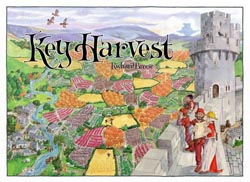 This week, there were four of us so I decided to try out Richard Breese’s latest game, Key Harvest. I was looking forward to this as the ‘Key’ series of games has been filled with very good game ideas.
This week, there were four of us so I decided to try out Richard Breese’s latest game, Key Harvest. I was looking forward to this as the ‘Key’ series of games has been filled with very good game ideas.
The idea behind the game is to score points by developing plots of land through planting and harvesting fields of particular crops and employing workers to help farm the land. A player’s turn involves taking two out of four possible actions: Firstly, you can initiate the sale of a plot of land, placing it in your store and setting a price in crops (we’re a bartering economy here) for that plot; you can buy a plot of land that has been offered for sale by you or another player, by paying the required combination of crops, and then immediately cultivate it; thirdly, you can employ a worker in your fields and he will give you an immediate benefit (such as awarding you a free harvest or recultivating an already harvested field); and finally you can harvest a group of fields to obtain the crops sown. Whenever plots of land are put up for sale, the market either brings a new plot onto the market or an event occurs. The events interrupt play and give players additional opportunities for developing their position. Once ten events have been drawn, the game ends and scoring takes place with points awarded for each worker employed, each player’s largest and second largest groups of fields and having the greatest stock of each type of crop.
There are some very good ideas in the game and there is a lot of angst in deciding which actions to take – you always want to do more than is available to you. However, our game suffered from the non-appearance of events: we went through six events pretty quickly and then they just dried up – I think the next event turned up over an hour later and, by that time, we were all pretty sure I had the game sewn up that we decided to call time a short while after. We all noted that it was pretty difficult to get the townsfolk into play and I was the only one whose field network really helped bring them into play: I managed to get one of the level 5 and two of the level four guys working for me, whereas only Mark G managed to get a level four worker into play.
I think the others were a bit disappointed – the first half of the game played really well but the tile draw meant that things stagnated badly. I’m not sure it was helped by the way we played as everyone was discouraged from putting things up for sale because, whatever the price set by the person initiating it, the other players were doing their utmost to stop that player from getting it. A bit of negative group-think. However, I would hope that with a better distribution of events and more competition for the townsfolk, another playing should restore my faith in the game – certainly other reports have been pretty positive.
John hosting next SBC session
 This week’s session on Friday 16th November will be at John’s house, as I am taking Jan down to London to see The Sound of Music.
This week’s session on Friday 16th November will be at John’s house, as I am taking Jan down to London to see The Sound of Music.
SR: 2nd November 2007 – Im Jahr des Drachen
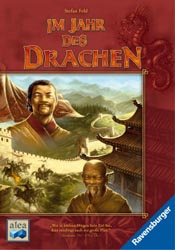 Alea has a very good reputation with me and I always look forward to their next game with interest. Although the English edition of their latest didn’t make it to Essen (Year of the Dragon by Rio Grande), I did get the German version and five of us sat down to test it out.
Alea has a very good reputation with me and I always look forward to their next game with interest. Although the English edition of their latest didn’t make it to Essen (Year of the Dragon by Rio Grande), I did get the German version and five of us sat down to test it out.
Players are Chinese rulers around the year 1000 and you are trying to protect yourself and your subjects as best as you can against disease, hunger or attacks from the Mongols while gaining prosperity and prestige. The game is played over 12 months (rounds) and each month is split into four phases. Firstly, each player picks one of seven possible actions, most of which activate workers in your palaces and gain you food, money or prestige points. In the second phase, you can recruit a new worker providing your palaces have space to accommodate him. Thirdly, an Event then takes place which, from the third month onwards, requires you to satisfy certain conditions (pay taxes, give up rice stocks etc.) If you are unable to meet the “cost” you will lose workers and, if your palaces then become uninhabited, they start to decay. Having dealt with the event, scoring takes place and you receive prestige points for each of your palaces, any court ladies you have recruited and any privelige tiles collected. After the 12th round, a final scoring takes place with bonuses for workers, buddhas and money remaining, following which whoever has the most prestige wins.
This is a very unforgiving game and, as you are bound to suffer some losses at some point during the game, you need to work out when is going to do least damage. Forward planning is critical. When we went through the rules, Nige thought it might be more fun to have the event tiles laid face down but we soon discovered that would have made the game impossible. I made a big mistake in one round, failing to anticipate exactly how much cash I was going to need two rounds later and it killed me. I hadn’t been doing brilliantly before then (paying 3 coins for my chosen action a few times as I was lagging behind on the person (turn order) track). However, my cashflow problem devastated my palace population and I knew that I was never going to recover. Nige was heavily into research and early on was raking in the prestige points. However, Mark K gave him some competition in research and that slowed him down. Mark G collected some priveliges and this brought him lots of points in each subsequent scoring but he, like me, got hit hard by events. Steve, on the other hand, managed to take some modest pain early on but then was able to build up a good cluster of palaces and crucially had buddhas in them at the end to score enough points in the final round to overtake Mark KÂ and tie for prestige with Nige. Unfortunately for Steve though, Nige was further advanced on the person track and claimed the win on the tiebreak.
This was another high quality game from Alea and designer Stefan Feld is making quite a name for himself with this joining Notre Dame as a big success.
Next SBC session
 The next session of the Shrewsbury Boardgames Club is on Friday 2nd November and is at Garry’s house.
The next session of the Shrewsbury Boardgames Club is on Friday 2nd November and is at Garry’s house.
SR: 26 October 2007 – Amyitis
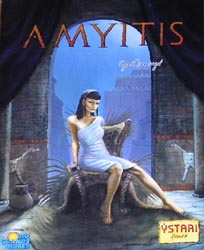 This week, there were just the three of us so, for our first taste of the Essen releases, I chose Amyitis, the new game by Cyril Demaegd published by Ystari and Rio Grande.
This week, there were just the three of us so, for our first taste of the Essen releases, I chose Amyitis, the new game by Cyril Demaegd published by Ystari and Rio Grande.
The game is based around the building of the Hanging Gardens of Babylon and each player represents a Babylonian seeking to raise his prestige by building gardens, the irrigation networks needed to support the gardens, by trading, and by recruiting peasants, priests, engineers and merchants to help them. Play takes place over several rounds and each round sees the player performing a number of actions to develop his position. The action takes place on two boards: The Babylon Board and the Mesopotamia Board. On the Babylon Board, recruit actions take place. The player can recruit a peasant to farm for resources, a priest to represent him in one of the three temples, an engineer to provide irrigation for an area of the gardens, or a merchant to gain camels. Camels are needed for the Mesopotamia Board, where you travel from city to city trading the resources you have collected for prestige points or Court cards (that improve certain abilities, such as being able to move further by camel, or income each round), or buying plants that immediately get placed in the gardens for additional prestige, coins, camels etc. The game ends when a certain number of the garden plots have been planted at which time bonuses are awarded for contributing a certain number of plants and whoever then has the most prestige wins.
Amyitis is another very nice game from Ystari. At the beginning, there are so many different choices you can make that it takes a while to get your head around what you are trying to do. However, there are many routes to try and progress can be made following very different strategies. The court cards you gain will determine how you try to progress but being frozen out of certain benefits does not doom you to failure. Mark K was unable to get a banker card which made money very tight for him but he was able to adapt and concentrating on the caravaneer enabled him to travel around the Mesopotamia board quite freely. Time-wise, this took us a bit longer than we thought but there is so much going on that the early rounds inevitably took a while. This shouldn’t be a problem in subsequent games. Mark K’s rating did, however, reflect the time taken to play. The result of our game came right down to the wire with Mark K managing to stop me from planting on the final turn, which would have given me enough to keep the lead. Instead, his 10 point bonus for planting 6 times gave him the win by just 2 points.
Back from Essen
Just back from Essen after two days of games and talking to friends I’ve not spoken to for twelve months. Here is this year’s haul of new games, not including a present of Le Passe Trappe Micro for Chris and a number of small expansions (Mykerinos, Zooloretto, Master Thieves). Lots of games for the club to go at in the coming weeks.

10 Days in Telford (or Africa)
I’ve tried out 10 Days in Africa as both a 2-player and a 3 player over the last few days and here is my review of it. The components are very good, 2 solid wooden tile racks per player to hold the tiles which in turn are also solid card stock. The slightly strange (for me) bit is the game board of Africa which is a mounted map of Africa with the countries in in five different colours. The bit I find strange is that it is mounted, when the board is only used as a aid to the geography of the continent and not actually played on. I can’t fault it’s durability but maybe it only needed to be a paper map.
The game play is quite straight-forward, you start by filling your tile racks one space at a time with an eye to putting together a route through Africa with as little future alteration as possible. Once that is done the remaining tiles form a face down stack and three tiles are turned face up (a bit like Ticket to Ride or Elfenland from the same designers). Each turn a player can take one of the face up tiles or a face down one, which they can use to exchange for a tile on their rack. They then discard onto one of the three face up piles.The idea is to achieve a 10 Day journey around Africa by using a combination of walking, (to an adjacent country) by car (linking two countries by driving through another) and by plane (between any two countries that share the same colour as each other and the plane). The first player to achieve this wins.
In my first game after my initial 10 tiles had been selected I found myself only needing 3 tiles and it wasn’t long before I gained the first of those, the Ivory Coast tile. This tile matched nicely with the Burkina Faso tile on one side and the orange plane trip to Chad. A car soon linked me: Mauritania to Niger and before long a second Sudan tile came into my possession, which linked my journey to Chad. This left me needing any one of eight countries to finish (As the other Chad tile had already gone). I only had to wait another two turns and the Central African Republic tile turned up for me to win.
I’ve played 4 games of this now, one was a 3-player and the rest have been 2-player. I’ve experienced one game where after the initial 10 tile set-up I’ve needed two tiles to complete the journey and have also experienced the other extreme of having very little that connects. All the games have taken no longer than 30 minutes and I’ve enjoyed them, but I think it’s a little bland, It lacked player interaction and as you don’t know how well your opponent is doing it also lacks a little excitement. Overall I rate it 6.5/10.Â
Â
Caylus session report – 4 Oct 2007
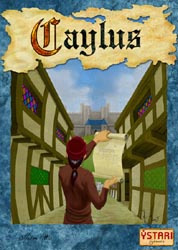 Caylus was the game of choice for the 5 of us, having decided to play a longer meatier game. Me, Will, Mark, Paul and Dave all set off on different strategies. Dave was the castle builder and favour getter, he set about improving his position on the favours track getting extra VP’s. Mark also made progress on the building track but his was the building option. I decided to get some early wooden building in, including the mason with the hope that the others would give me VP’s by using my buildings. Paul had a similar plan and we both went for money on the favours track with perhaps a long term view to buying our way to victory. Will went in completely the opposite direction and decided money wasn’t a problem, he went for extra resources on the favours track; he was to find out later (along with the rest of us) that money or the lack of it can be a big problem.
Caylus was the game of choice for the 5 of us, having decided to play a longer meatier game. Me, Will, Mark, Paul and Dave all set off on different strategies. Dave was the castle builder and favour getter, he set about improving his position on the favours track getting extra VP’s. Mark also made progress on the building track but his was the building option. I decided to get some early wooden building in, including the mason with the hope that the others would give me VP’s by using my buildings. Paul had a similar plan and we both went for money on the favours track with perhaps a long term view to buying our way to victory. Will went in completely the opposite direction and decided money wasn’t a problem, he went for extra resources on the favours track; he was to find out later (along with the rest of us) that money or the lack of it can be a big problem.
The wooden buildings and then the stone buildings were shooting up so fast that even the seemingly jet propelled provost couldn’t keep pace and the Bailiff found itself well behind the lead buildings. The speed of the Bailiff did however cause a minor panic at the end of each phase of castle development with players having to scramble workers and materials together to get a presence in the castle or suffer the VP penalty. On one such occasion Will did get a worker into the castle but due to forgetting to move the provost to a resource building another of his workers was on, wasn’t able to acquire the necessary cubes to build a part of the castle. He therefore lost VP’s for not building that go and for not having a presence at the end of the phase.
That’s the danger in Caylus, it’s about remembering the activation sequence and although you have fixed in your mind that you’ve got the resources from worker placement, you’ve got to remember the other important things like having the resources at the right time or remembering to move the provost to activate them. Later in the game a player (who may or may not have been Will, but whose name rhymes with Bill) wanted to build a prestige building, one worker was placed on the architect and the other on the alchemist to get the necessary gold, but the architect activated before the alchemist and therefore no gold. It’s a mistake that can easily catch you out because in your mind you already have that gold.
Will’s money (or lack of it) problem manifested itself later in the game and he found himself only being able to activate 3 workers each turn for a number of turns, this of course had the knock on effect of making worker placement more expensive for the rest of us after the first 3 had been placed. No one seemed able (or willing) to afford to place all of their workers. Using your own buildings (which always cost 1 to use) became very popular.
In the final stages Mark had worked himself into a good position and was able to buy the Cathedral (25VP’s), this placed him a good 10pts clear of the rest of us. He then attempted to get the game finished quickly and would have done so had he remembered to send a worker to move the provost. He had the opportunity but I took advantage of his slip to move the provost back 3 spaces and that took the game into a final turn. This gave us back markers a last chance to catch Mark who did have one more card up his sleeve and was able to get a gold resource cube which he used to buy the statue with it’s 7VP’s and one favour (used to get another VP of course). Dave practically finished building the castle single handed and with the favours flooding in he was now getting 5VP’s per favour, he almost caught Mark but finished just 2 points behind.
A well worked win for Mark and only 7 points from first to fourth with Will trailing slightly further back. This is one of our favourite games and will no doubt see a early return to the table.
And the winner is … me!
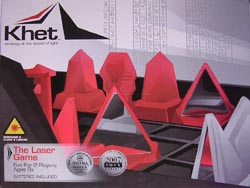 Just over a week ago, I got an e-mail from Eric Martin ( the editor of Boardgamenews) to let me know I’d won a copy of the Khet prize pack in the most recent BGN Game Giveaway. A week later and a box from Kentucky arrives on the doorstep and I’m now the proud owner of Khet: The Laser Game. The pack includes the main Khet game, a beamsplitter expansion and a Khet T-shirt.
Just over a week ago, I got an e-mail from Eric Martin ( the editor of Boardgamenews) to let me know I’d won a copy of the Khet prize pack in the most recent BGN Game Giveaway. A week later and a box from Kentucky arrives on the doorstep and I’m now the proud owner of Khet: The Laser Game. The pack includes the main Khet game, a beamsplitter expansion and a Khet T-shirt.
The game itself looks pretty interesting where you manoeuvre your pieces so that when you fire your laser, the beam bounces off the mirrored surfaces on certain pieces until it hits something solid. If it’s a wall, your opponent gets a go. If it’s another piece, it gets removed from play and if you hit the opponent’s pharaoh (the king), you win. I’ll let you know what it’s like when I get to play it for real, rather than just fiddling with the lasers.
